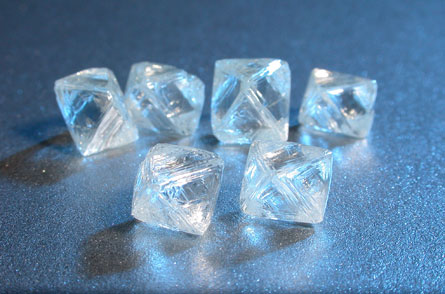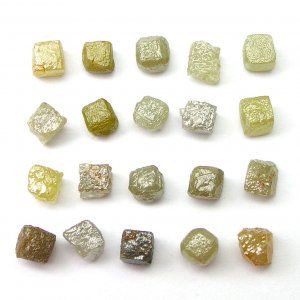“We believe that the future of diamonds is in branded diamonds,”
Philippe Mellier, De Beers chief executive officer (Israel – June 26, 2013).
“The example of Dominion’s Ekati [mine] purchase and the Harry Winston retail sale, shows a clear choice made between production and marketing,”
Fyodor Andreev, ALROSA CEO (Angola – June 20, 2013).
There are two faces to the diamond mining sector and each has a clear but different strategy on how to strengthen their position in the market. The pure-play diamond producers, led by ALROSA, are looking to drive value through increased production volume and forecasted price escalation, while De Beers and Rio Tinto Diamonds are using strong branding initiatives in an attempt to stimulate growth.
While it is left to their respective shareholders to decide whether these strategies are right or wrong, the diamond market itself should question what added value each strategy is in fact bringing to the industry table. The polished market needs to assess its relationship with rough suppliers in light of high rough prices and tight diamond manufacturing margins.
But first, let’s take a look at the different players.
ALROSA is drumming up its production potential ahead of its initial public offering (IPO) scheduled for the fourth quarter of 2013. The Russia-based company plans to raise annual production from 34.4 million carats in 2012 to 38 million carats by 2020. With its “conservative” estimate that rough prices will grow at 3 percent per annum, ALROSA’s management is proclaiming that its revenue will exceed that of De Beers within five years.
Like ALROSA, most of the listed mid-tier mining companies are pushing their production. These include Canada-focused Dominion Diamond Corporation – formerly Harry Winston Diamond Corp. – and South Africa-focused Petra Diamonds. Each significantly increased their mining portfolios recently while shying away from any marketing investment. Dominion bought BHP Billiton’s Ekati mine and subsequently sold its Harry Winston retail operation to Swatch, while Petra has bought a number of De Beers mines, including the iconic Cullinan and Finsch mines.
It could be that their shareholder structures are influencing their respective strategies.
Bob Gannicott, Dominion’s CEO, explained in a recent interview with JCK Magazine that maintaining a dual identity was difficult as a public company. “In a business sense, vertical integration works very well. Our ownership of Harry Winston was very profitable for us,” he said. “But in the stock market, there is either a mining analyst or luxury goods analyst. As a private company, I wouldn’t hesitate to combine the businesses. But it’s harder as a public company.”
When speaking to potential investors, the diamond mining companies have a relatively simple sales pitch. Their argument is that with a limited global supply and rising consumer demand, prices will rise in the long term and value will be driven by a company’s production potential.
While De Beers and Rio Tinto push that same agenda, and have the production volume to do so, they complement their production with extensive marketing and branding activities.

It could be argued that Rio Tinto’s ongoing diamond brand development during its 15-month-long business review tipped its decision to keep the unit. It should be noted that the group continues to sell off other non-core operations. It could also be that there were just not enough suitors for the diamond business. Still, for the industry’s purposes, the decision shows a clear choice made between marketing and production.
What differentiates De Beers and Rio Tinto Diamonds from other companies in the industry is that they are part of conglomerates. That may provide them with some flexibility to pursue their respective marketing focus. After all, analysts don’t cover De Beers or Rio Tinto Diamonds in their own right but as divisions of Anglo American and the Rio Tinto Group. Then again, it may be the parent companies pushing the agenda.
The question then is what focused mining groups such as Anglo American and Rio Tinto have to gain from these branding initiatives. What value do these branding and marketing activities bring to the group? Perhaps it is their historic roles as diamond marketers that attracted Anglo to increase its involvement in De Beers and inspired Rio Tinto to keep its diamond unit.
Rio Tinto’s strategy, which includes its ‘Diamonds with a Story’ initiative and Nazraana brand to promote diamond gift giving in India, presents a less ambitious revenue stream. In the past, the company has also been at the forefront of pushing an industry-wide generic marketing campaign.
De Beers is focused on Forevermark as its premium brand, having shed its involvement in generic marketing. Forevermark gains revenue from its grading and inscription services while its manufacturing and retail partners pay an annual fee to carry the brand. There are also stated plans to expand the Forevermark grading service to non-Forevermark diamonds. How large that revenue stream can develop and what proportion of De Beers total it will represent in the long term is anyone’s guess.
What is clear is De Beers intent to expand Forevermark’s retail reach. Philippe Mellier, De Beers CEO, reported that the brand is currently showcased in close to 1,000 stores globally, of which about 350 are in the U.S. He added that more sightholders are partnering with De Beers in cutting and polishing for Forevermark.
Some sightholders have expressed concern that Forevermark competes with their own branding initiatives, which may represent a possible conflict between buyer and supplier. Mellier dismisses this and points out that Forevermark branding and De Beers campaigns, such as its 2012 ‘Center of My Universe’ promotion, create a buzz around diamonds and effectively spur overall demand for diamonds.

That is welcome news for the industry in the absence of generic marketing for diamonds. Competitive branding certainly has its overall effect to raise consumer interest in diamonds. For example, it will be exciting to see what the impact of Rio Tinto’s new consumer advertising campaign in India for Nazraana – announced this week – will be when pinned against the likes of Forevermark or Tanishq or Gitanjali’s extensive advertising. Similar battles are being witnessed in the U.S., China, Japan and other consumer markets.
But how comfortable is the polished diamond market with a mining company that is involved at the consumer end? Or how comfortable is it in the knowledge that such major players as ALROSA, Dominion and Petra Diamonds are absent from driving consumer demand? Ultimately, what effect will this have on diamond prices and profit margins throughout the rest of the pipeline?
There is no doubt that the aim of diamond mining companies in utilizing either strategy is to drive up the price of rough. However it appears that De Beers and Rio Tinto are the only mining companies making an active transparent investment to achieve this.
But regardless of which philosophy they adhere to, the two faces of the mining sector at least have a clear vision regarding how to drive their own growth and maintain their own positions of strength in the market. That is lacking in the polished segment, which in the past few years has had to navigate high rough and cautious polished price trends. It is up to companies in the polished sector to compete and create their own added value position in the market. Either that, or endure continued pressure and dominance from their well-oiled mining peers.
